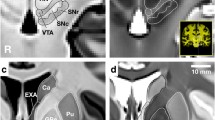Abstract
We describe a 3D surface-tracking algorithm that is used to detect the interior laminar surfaces of a solid shell. Each of these surfaces is called a “peel”. Successive peels may be generated, thus representing the solid shell by its tangential layers. This algorithm is based on voxel surface-tracking methods and solves the problems associated with transforming a surface-tracking algorithm into a “brain peeler”. We also discuss the properties of the voxel surfaces produced by this algorithm. Using the connectivity properties of these objects, we are able to convert voxel representations into polyhedral representations without human interaction. We illustrate this work with a high-resolution reconstruction of a monkey visual cortex. Additional application domains of this work are in areas in which there is a natural laminar structure to a 3D solid, such as in geophysics (earth strata).
Similar content being viewed by others
References
Anjyo k, Ochi T, Usami Y, Kawashima Y (1987) A practical method of constructing surfaces in three-dimensional digitized space. The Visual Computer 3(1):4–12
Artzy E, Frieder G, Herman GT (1981) The theory, design, implementation and evaluation of a three-dimensional surface detection algorithm. Computer Graphics and Image Processing 15:1–24
Binford TO (1971) Visual perception by computers. Proc. IEEE Conf. Systems and Control. Miami, Florida
Roissonnal JD (1984) Geometric structures for three-dimensional shape representation. ACM Trans Graph 3(4):266–286
Boissonnat J (1989) Shape reconstruction from planar cross sections. Computer vision, graphics, and image processing 44:1–29
Cavendish C, Field DA, Frey WH (1988) An approach to automatic three dimensional finite element mesh generation. General Motors Tech Rep GMR-4533
Christiansen H, Stephenson M (1983) MOVIE.BYU. Univ Press, Brigham Young Univ
Faugeras OD, Hebert M, Mussi D, Boissonnat JD (1984) Polyhedral approximation of 3-D objects without holes. Computer Vision, Graphics, and Image Processing 25:169–183
Fuchs H, Kedem ZM, Useiton SP (1977) Optimal surface reconstruction from planat contours. Commun ACM 20:693–702
Kaplow WK, Schwartz EL (1986) An interactive system for alignment and manipulation of images of brain sections: BITBOX. Comp Neuro Tech Rep CNS-Tech Rep-20-86, NYU Med Ctr Computa Neurosci Labs
Kaplow WK, Schwartz EL (1986) Data formatting and software tools for grayscale run-length encoding of image data. Comp Neuro Tech Rep CNS-Tech Rep-21-86, NYU Med Ctr Computat Neurosci Labs
Keppel E (1975) Approximating complex surfaces by triangulation of contour lines IBM J Res Devel (January 1975), 2–22, IBM
Landau P, Schwartz EL (1987) A three dimensional median filter: applications to repair of damaged brain sections and to interpolation of serial sections, Comp Neuro Sci Tech Reports CNS-Tech Rep-I-87
Schwartz EL, Christman DR, Wolf AP (1983) Human primary visual cortex topography imaged via positron-emission tomography. Brain Res 104
Schwartz EL, Merker B, Wolfson E, Shaw A (1988) Computational neuroscience applications of computer graphics and imace processing to two and three dimensional modeling of the functional architecture of visual cortex. IEEE comput Graph Appl (July 1988), pp 13–28
Schwartz EL, Snaw A, Wolfson E (1989) A numerical solution to the generalized mapmaker's problem. IEEE Trans Pattern Anal Mach Intell
Shaw A, Schwartz EL (1988) Automatic construction of polyhedral surfaces from vexel representations. Comput Vision Graphics and Image Processing (submitted May 1988)
Wallace AH (1968) IN: Differential Topology. WA Benjamin. New York
Wolfion E, Schwartz EL (1989) Computing minimal distances on arbitrary polyhedral surfaces. IEEE Trans Pattern Anal Mach Intell
Zyda MA, Jones AR, Hogan PG (1987) Surface construction from plane contours. Comp Graph 11:393–408
Author information
Authors and Affiliations
Additional information
Supported by System Development Foundation, AFOSR 85-0341, and the Nathan S. Kline Psychiatric Research Center
Rights and permissions
About this article
Cite this article
Frederick, C., Schwartz, E.L. Brain peeling: viewing the inside of a laminar three-dimensional solid. The Visual Computer 6, 37–49 (1990). https://doi.org/10.1007/BF01902628
Issue Date:
DOI: https://doi.org/10.1007/BF01902628




